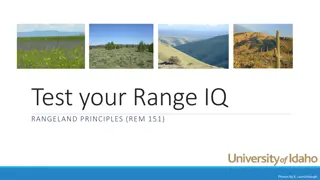Rangeland Condition Changes in Kyrgyzstan 2000-2020 Analysis
Detailed analysis of rangeland condition changes in Kyrgyzstan from 2000 to 2020 utilizing remote sensing data and local information. Focus on impact assessment, climate resilience, and poverty reduction. Data processing involved calculation of various vegetation indices and degradation assessment following IPCC guidelines.
Download Presentation

Please find below an Image/Link to download the presentation.
The content on the website is provided AS IS for your information and personal use only. It may not be sold, licensed, or shared on other websites without obtaining consent from the author.If you encounter any issues during the download, it is possible that the publisher has removed the file from their server.
You are allowed to download the files provided on this website for personal or commercial use, subject to the condition that they are used lawfully. All files are the property of their respective owners.
The content on the website is provided AS IS for your information and personal use only. It may not be sold, licensed, or shared on other websites without obtaining consent from the author.
E N D
Presentation Transcript
Rangeland condition changes over the period 2000-2020 for Kyrgyzstan By GMV ESA UNCLASSIFIED - For Official Use
IFADs Livestock and Market Development Programme II (LMDP2 ) Project Goal Reduce poverty and enhance economic growth in pasture communities from Kyrgyzstan by improving livestock productivity and climate resilience and thereby promoting equitable returns to livestock farmers. EO4SD CR results of interest for the following processes o Completion mission of LMDP2 o Impact assessment of LMDP2 o NDC update of KGZ o Pasture Community Mapping These are only the ones IFAD is involved in. IFAD s KGZ partners are also very interested ESA UNCLASSIFIED - For Official Use EO4SD Climate Resilience Cluster | February 2021 | Slide 2
Input datasets Spectral bands for 2000-04 (Landsat-5 and -7) and 2016-20 (Landsat-8) Local rangeland information at regional and sub-regional scale provided by Camp Alatoo Public Foundation Seasonal grazing periods (up to 28 different grazing periods were considered) Seasonal grazing altitudes Pastures distance to villages in winter Grazing on slopes FAO s Land Cover product (2019) for Kyrgyzstan Digital Elevation Model (SRTM 30 m) ESA UNCLASSIFIED - For Official Use EO4SD Climate Resilience Cluster | February 2021 | Slide 3
Input datasets e.g., Local information for Jalalabad Buffer size of winter pastures around villages 500 m 500 m 200 m Oblast (or even PUU) District AA Grazing periods Pasture altitudes Winter Spring/autumn 1 Apr -20 May, 1 Sep -10 Nov 1 Apr -20 May, 1 Sep -10 Nov 1 Apr -31 May, 1 Sep -15 Nov Summer 20 May - 1 Sep 20 May - 1 Sep 1 June -31 Aug Winter 900-1000 1300 1500-1800 1500-1900 Spring/autumn 1300-1500 1500-1800 Summer 1400-2200 1700-3200 1900-3100 Aksy Jergetal Kerben Atay 11 Nov -31 March 11 Nov -31 March 16 Nov -31 March Jalalabad Toguz-Toro ESA UNCLASSIFIED - For Official Use EO4SD Climate Resilience Cluster | February 2021 | Slide 4
Data processing Ensuring the radiometric consistency between the different sensors (i.e. TM, ETM+ and OLI) Calculation of Landsat-based vegetation indices (NDVI, MSAVI, SAVI, EVI), moisture index (NDMI), burn ratio indexes (NBR, NBR2) and vegetation health indexes (VCI, VHI) for the periods 2000-2004 and 2016-2020 5-years bands average of 15-days-based sub-periods within each grazing period (2000-04 and 2016-20) Extraction of maximum value of each index for each grazing period Degradation obtained following the IPCC s guidelines regarding Grasslands degradation Severely degraded: <70% of reference value Up to 9 Rangeland condition changes maps per each grazing period Moderately degraded: 70 95% of reference value Non-variation: 95.1 105% of reference value Enhancement: >105.1% of reference value [9 x 28 = 252] ESA UNCLASSIFIED - For Official Use EO4SD Climate Resilience Cluster | February 2021 | Slide 5
Indices analysis Auto-correlation analysis of the indexes in each region and season Index only considered when less of the 75% of similarity is obtained Assessment of pastureland status -> weighted composite of indexes Weights defined through an importance estimation analysis of the indexes Qualitative in-situ pasture state observations from FAO s PRAGA project. Good Moderate Bad Estimates from random forests classifier However, ESA UNCLASSIFIED - For Official Use EO4SD Climate Resilience Cluster | February 2021 | Slide 6
Indices analysis the reduced availability of observations and their geospatial concentration result in very similar importance for all indexes across seasons and regions 0.2 0.15 Importance 0.1 0.05 0 ESA UNCLASSIFIED - For Official Use EO4SD Climate Resilience Cluster | February 2021 | Slide 7
Indices combination Rangeland condition changes tailored for each region and season Indexes not auto-correlated Weighted sum model (WMS) using the estimated importance of each index Results: Value 1: Severely degraded Value 2: Moderately degraded Value 3: No variation Value 4: Enhancement Confidence level of the results Difference between resulting rangeland condition change and the results obtained by the individual indexes weighted by its importance Classified into three classes for improving the readability (Low, Moderate and High) ESA UNCLASSIFIED - For Official Use EO4SD Climate Resilience Cluster | February 2021 | Slide 8
Indices combination Example of the combination procedure NDVI 1 0.1 No 0.13 0.13 EVI 1 0.1 Yes - - SAVI 1 0.22 No 0.29 0.29 MSAVI NDMI 2 0.05 Yes - - NBR 1 0.1 No 0.13 0.13 NBR2 1 0.1 No 0.13 0.13 VCI 3 0.05 Yes - - VHI 4 0.23 No 0.31 1.23 Rangeland status value Index importance Index is auto-correlated? Recomputed Importance Value Recomputed Importance Weighted Sum Model result Rounded Result (Final Rangeland condition change) abs(value - rounded result) abs(value - rounded result) / 3(*) [abs(value - rounded result) / 3(*)] Recomputed importance Uncertainty (average weighted differences) Classified uncertainty (based on empirical adjustment) (*) 3 is the maximum possible difference between one index value status and the rounded result 2 0.05 Yes - - 1.92 Rangeland condition changes 2 (Moderately degraded) 1 1 1 1 2 - - - - - - - - 0.33 0.33 0.33 0.33 0.67 confidence Level of 0.04 0.10 0.04 0.04 0.82 - - - - 0.21 Low (<0.2) | Moderate (0.21-0.4) | High (>0.41) ESA UNCLASSIFIED - For Official Use EO4SD Climate Resilience Cluster | February 2021 | Slide 9
Defining target areas DEM-based altitude ranges for rangelands per season and region Slope lower than 45 Distance to villages (applicable in winter only) Precipitation variation between both analyzed periods (2000-04 and 2016-20) lower than 33% (source CHIRPS at 5 km) -> GHG models cannot produce realistic results for higher values Rangelands baseline: Grasslands from FAO LULC map (30 m) AI-based model to obtain a grassland classification for both periods. FAO s map used for training Revised by local stakeholders and re-trained using feedback Rangelands which turned into urban, bare soils or crops severely degraded ESA UNCLASSIFIED - For Official Use EO4SD Climate Resilience Cluster | February 2021 | Slide 10
Rangeland condition changes (Winter) Rangeland condition changes Severe degradation Moderate degradation No variation Enhancement Uncertainty Low Moderate High ESA UNCLASSIFIED - For Official Use EO4SD Climate Resilience Cluster | February 2021 | Slide 11
Rangeland condition changes (Spring) Rangeland condition changes Severe degradation Moderate degradation No variation Enhancement Uncertainty Low Moderate High ESA UNCLASSIFIED - For Official Use EO4SD Climate Resilience Cluster | February 2021 | Slide 12
Rangeland condition changes (Summer) Rangeland condition changes Severe degradation Moderate degradation No variation Enhancement Uncertainty Low Moderate High ESA UNCLASSIFIED - For Official Use EO4SD Climate Resilience Cluster | February 2021 | Slide 13
Rangeland condition changes (Autumn) Rangeland condition changes Severe degradation Moderate degradation No variation Enhancement Uncertainty Low Moderate High ESA UNCLASSIFIED - For Official Use EO4SD Climate Resilience Cluster | February 2021 | Slide 14
Rangeland condition changes All seasons combined Degradation No variation Enhancement More than one seasonal trend ESA UNCLASSIFIED - For Official Use EO4SD Climate Resilience Cluster | February 2021 | Slide 15
Statistics for rangelands Season Winter Spring Summer Autumn Ha % Ha % Ha % Ha % Severely degraded 420270 82.3 974410 33.5 2529140 43.2 865463 29.4 Moderately degraded 60374 11.8 1583127 54.3 2924358 50.0 1816875 61.7 No variation 28828 5.6 352074 12.1 394405 6.7 260937 8.9 Enhancement 1349 0.3 3241 0.1 4368 0.07 2571 0.09 ESA UNCLASSIFIED - For Official Use EO4SD Climate Resilience Cluster | February 2021 | Slide 16























